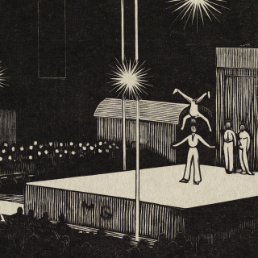Seventy years have passed since the death of Marc Gonthier (1895–1954), an artist who left behind a technically impressive oeuvre of prints spanning a wide array of motifs. His works depict lake and mountain landscapes surrounding Lake Geneva, farmers toiling in Bern and the dazzling world of circus performance.
By Kristina Pfister
The circus is a place of wonder and amazement, but also of illusion and deception. Artists manipulate, shape and trick the immediate perception of their audiences. Scenes from circuses and fairs form a significant part of Marc Gonthier’s oeuvre. His work demonstrates a lasting fascination for the eccentricities of circus life.
The arena at night

The wood engraving “Arène” shows two acrobats performing a daring trick on a well-lit stage. One acrobat is balancing on the other’s head; upside down and with all limbs extended, he appears to float. The stage – the front of which is emblazoned with the initials “MG” – is illuminated by spotlights. Two trapezes and a slightly open, rustling curtain promise the audience further flights of fancy and amazing feats. The faces of the spectators on the left reflect the artificial light from the stage.

No facial expressions have been drawn, however, and the faces of the audience appear as bright dots amid a sea of darkness. They serve as an important element in the image – both in terms of composition and content – connecting the spectators with the artists on stage. The contrast between black and white, which is created by the saturated print colour and the artificial light of the spotlights, harmonises with the scripted drama unfolding on stage. Gonthier himself bears witness to the dazzling performance depicted here. He has assumed the perspective of a spectator, observing both the audience and the acrobats on stage. As the creator of the print, he passes on this experience to his viewers – the artist becomes the director. The balancing act on stage is not what is central to the visual message, but rather the dynamic exchange between the viewers and the performers.
The circus as a recurring motif

Gonthier created numerous other prints that highlight his fascination with the circus. The visitors to the fair in his prints “Chiromancienne” and “Voyante extralucide” take part in seemingly supernatural moments with palm readers and psychics, becoming volunteers in the illusion. The composition melds the artists and spectators together; for the duration of the act, the two become one. Bridget Alsdorf describes this phenomenon in her 2022 book “Gawkers”: “This mirroring and flipping between performer and badaud conveys the tight connection between badauderie and the making and viewing of Art.”
The art of illusion

The acrobats are dependent on the goodwill of the spectators, who in turn allow themselves to be amazed by the illusions playing out on stage. In this way, the audience is turned into the object and “recipient” of the performance. The art of illusion is repeatedly reborn in the presence of onlookers.
Art in particular is a medium that makes the process of illusion possible. The artist influences his audience through the way he works – when cutting the wooden printing plate with his stylus and graver, he shapes both the material and the perception of the viewer. Gonthier also became a master of illusion through his use of woodcutting techniques. Using sophisticated shading techniques, he depicted scenes that suggested objects in motion, like the rustling curtains in “Arène”. He marked the print with his initials in the upper lefthand corner and also emblazoned them on the front of the stage. This view has striking similarities with a wooden printing plate itself.

Gonthier’s image composition in “Arène” suggests an equivalency between circus artists and visual artists. He conveys the close connection between producing and viewing art, a process in which a work of art only achieves its full development once it is perceived by an audience. An artist’s capability is measured by how well he can model the viewer’s perception – something that Gonthier pulls off superbly in this image.
Marc Gonthier was born as Robert Alfred Gonthier in Lausanne on 6 March 1895. From 1913 to 1915 he attended the École des Beaux-Arts in Geneva and was a student of Cuno Amiet in Oschwand (BE) from 1917 to 1919. In 1920 he received the first of three scholarships from the Commission Fédérale des Beaux-Arts. He moved into his studio in Quartier Mon-Repos in Lausanne and became a member of the Société des peintres, sculpteurs et architectes Suisses (SPAS). Gonthier participated in national art exhibitions in Geneva, Bern and Zurich. In 1953 he exhibited his work in connection with the Xylon art collective. He was also part of the art groups “Tailles et Morsures” and “Der graphische Kreis”. Gonthier died suddenly on 16 September 1954 at age 59.
Bibliography and sources
- Bridget Alsdorf: Gawkers. Art and audience in late nineteenth-century France. Princeton, New Jersey: Princeton University Press, 2022.
- Béatrice Béguin and Philippe Kaenel (eds.): Pleins feux! La Collection d'art de la Ville de Lausanne. Lausanne: art&fiction publications, 2017.
- Peter Küchler: Knie. 100 Jahre Schweizer National-Circus Knie. Rapperswil: Gebrüder Knie, Schweizer National-Circus AG, 2019.
- Nicole Minder and Nicole Pastori Zumbach, Gravures de Marc Gonthier. [Exhibition at the Cabinet cantonal des estampes, Musée Jenisch, Vevey, Catalogue], Vevey, 1992
- F.-R. Rahn: Un peintre, un graveur, Marc Gonthier. In: Lectures du Foyer: revue hebdomadaire illustrée, 18.5.1940.
Last modification 06.06.2024
Contact
Swiss National Library
Prints and Drawings Department
Hallwylstrasse 15
3003
Bern
Switzerland
Phone
+41 58 462 89 71






